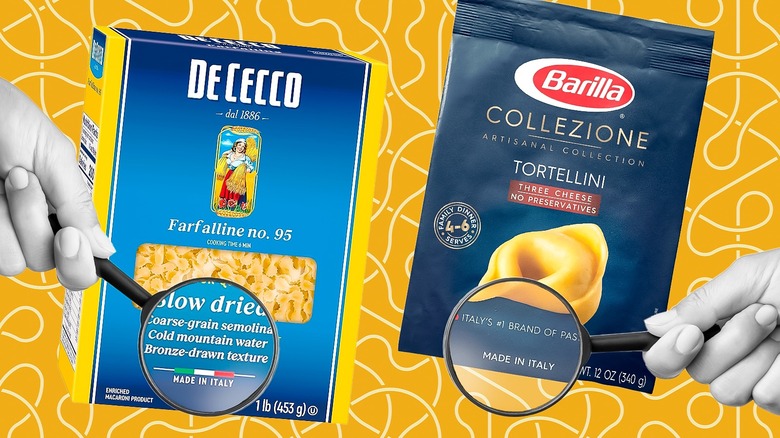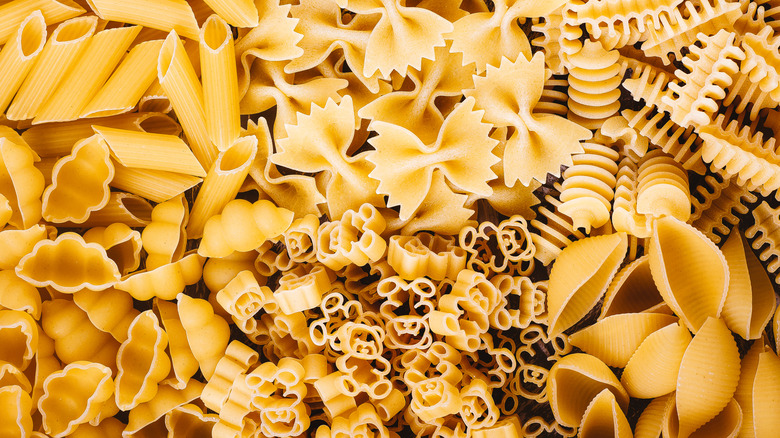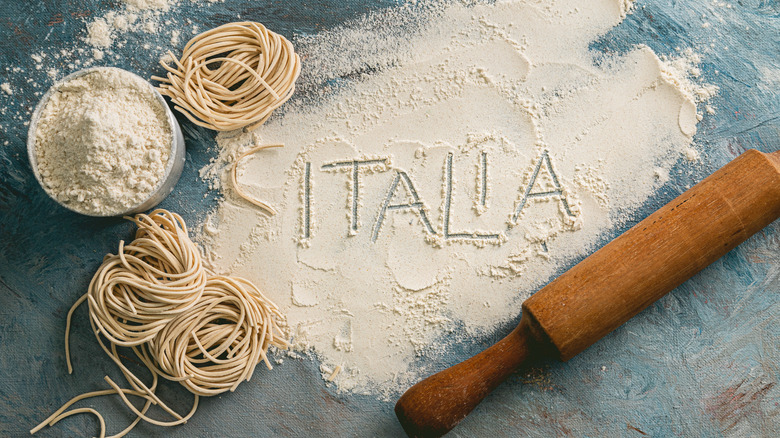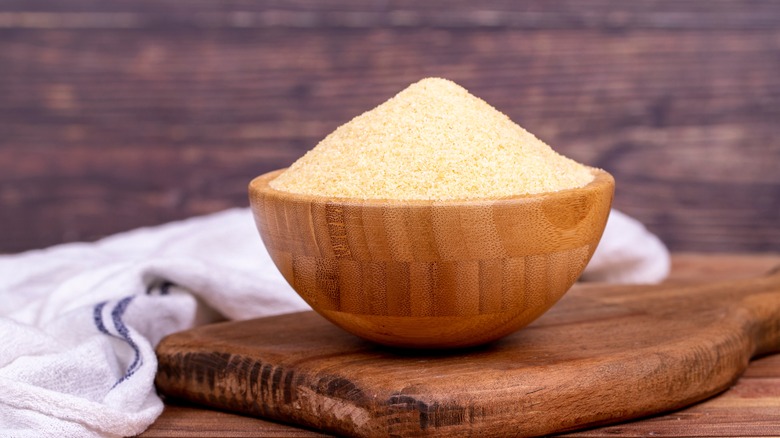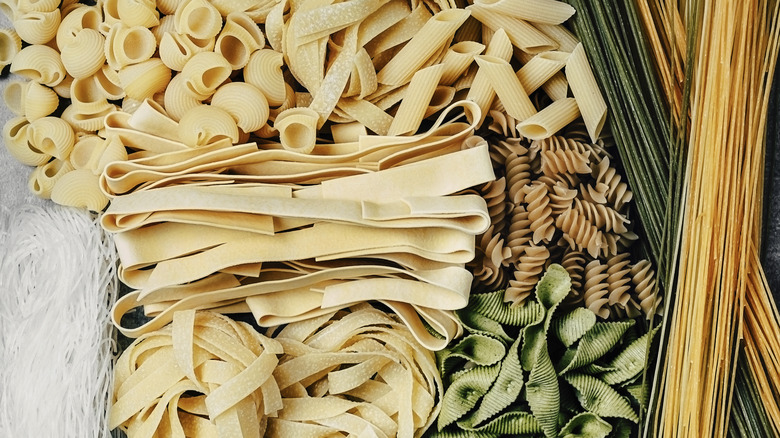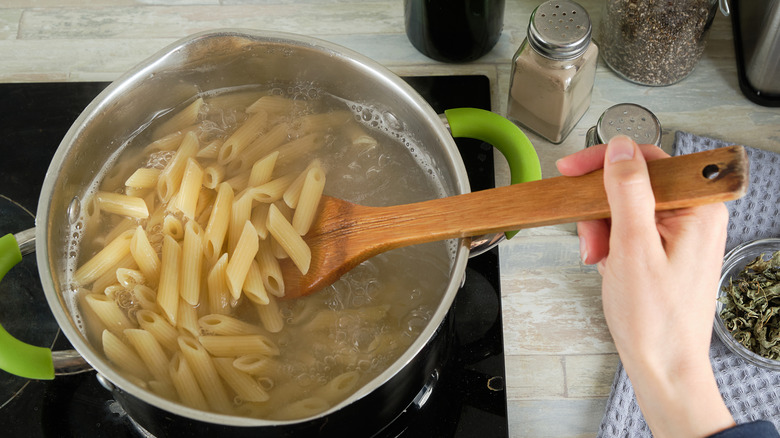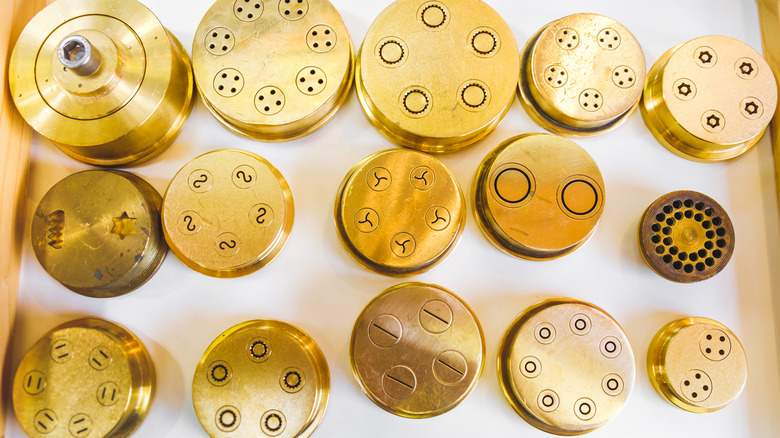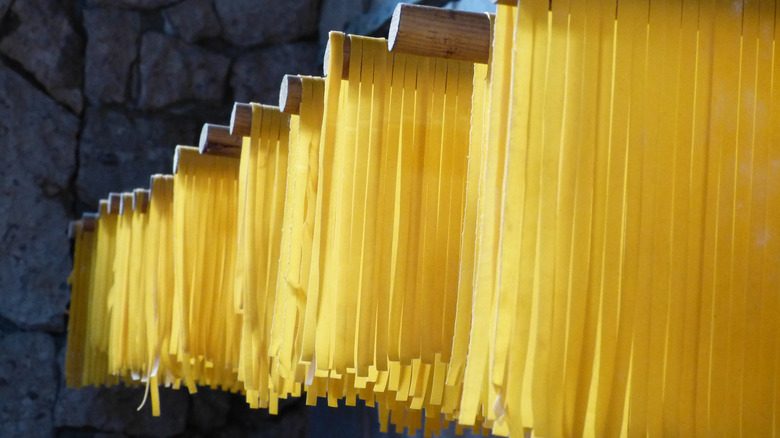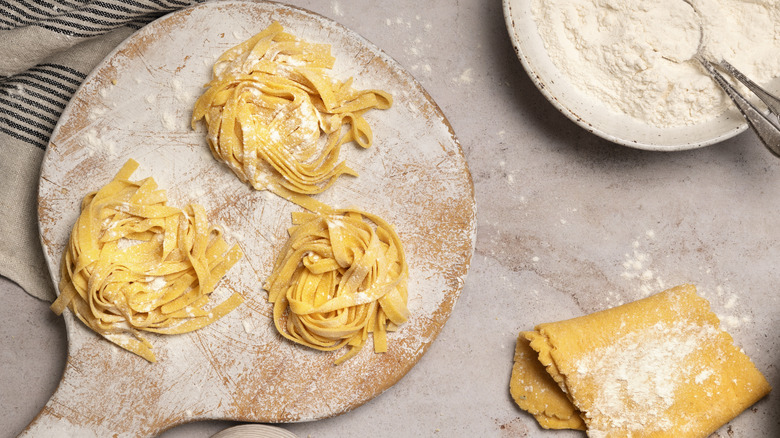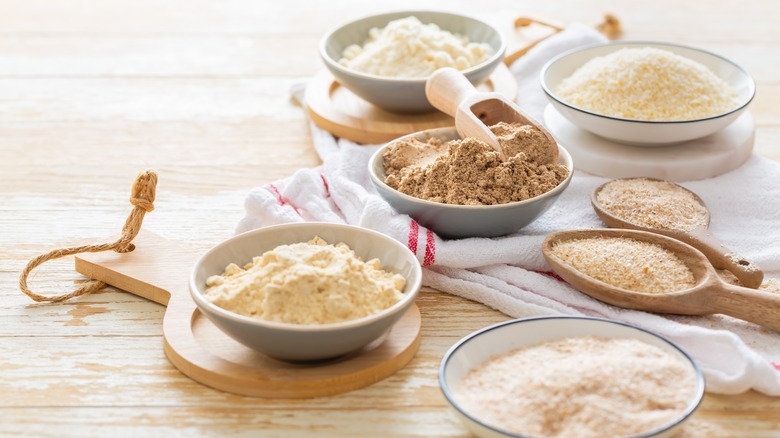9 Things A Chef Looks For On The Label Before Choosing Store-Bought Pasta
Wander through your local grocery store and you'll find a wall of dried pasta lining the aisle and a broad selection of fresh pasta in the refrigerated section. It can be tough enough trying to determine the exact type of pasta you should be using for your recipe, but how do you know which one features just the right criteria for your slow-cooked Sicilian sauce or your noteworthy classic carbonara? After all, you want your pasta to shine just as much as your delicious accompaniments. The basic make-up of pasta is flour and water, and sometimes eggs depending on the region the pasta resides from. Since only a few simple ingredients create this popular Italian food, how do you decide which pasta to look for when you're at the store? Are they all the same?
Tasting Table consulted with pasta experts to get the lowdown on how to properly read the label on store-bought pasta. We spoke with executive chef Albert Di Meglio of Barano — an Italian restaurant that features handmade pasta — about determining the quality of the ingredients. We conversed with Mark Tosi, president of Pastene — long-standing company of Italian products — about processing and cooking pasta. We also chatted with Joe Isidori — restaurateur and third-generation New York chef with Italian flair — regarding the importance of ingredient sourcing. We wanted to know what mattered on a pasta label and how you can know you're getting a quality product.
1. The type and shape of the pasta
Each type of pasta — whether it's ziti, spaghetti, shells, or bow-tie — serves a particular purpose for the other ingredients the pasta is prepared with. While many popular types of pasta are versatile enough for a number of different dishes, pasta is created and shaped with the final dish in mind. So when you're shopping for store-bought pasta, one of the first things you want to look for is the specific type of pasta that's needed for your meal. Sometimes, pasta types go by multiple names — such as capellini or angel hair, conchiglie or shells, and macaroni or elbows. Conveniently, most store-bought pasta has a clear window so you can actually see what type and shape you're buying.
How do you know what type of pasta to get? Typically, thick pasta that's shaped in large pieces, like gemelli, rigatoni, and radiatori, goes great with heavy, meaty sauces or denser ingredients like beans or ricotta cheese. This type of pasta also does well when it's a part of cold salads because it holds its bite while also absorbing the flavors around it. Thinner, lighter pasta, such as linguine, farfalle, and capellini shines when the accompanying ingredients are just as light. That type of pasta goes well with a simple cream sauce, oil-based dressing, or delicate vegetables or seafood.
2. Ingredients sourced from Italy
The word pasta means paste in Italian, referring to the mix of flour and water. But where the flour is sourced can make a big difference. The type of flour used is what determines you have a bowl of pasta ready for red sauce or a bowl of noodles ready for chicken broth. To the discerning taste buds, there's a notable texture and flavor difference between pasta and standard noodles. Both may be comprised of wheat and flour but where the wheat comes from and how it's processed makes a regional difference.
The No. 1 thing to look for on a pasta label, according to all of our experts, is that the pasta is made with ingredients sourced from Italy. "Always look for Italian-made pasta," chef Albert Di Meglio tells us. "They will use flours from Italy that are of higher quality and better for digestion." Even though Mark Tosi doesn't feel the source of the pasta matters, he admits his family "has sourced directly from Italy for the last 150 years."
3. Durum semolina wheat as the first listed ingredient
"Dried pasta should have two ingredients: semolina flour and water," chef Albert Di Meglio says. "If there is anything other than egg, keep looking for a different brand," he suggests. Pasta doesn't require many ingredients so it's pretty crucial those ingredients are top tier. Specifically, "durum semolina wheat should always be listed first on the label," Mark Tosi informs us. This indicates high-quality pasta, he says. Durum semolina wheat is top tier because it creates a strong dough from a high protein and gluten content. This one-two building block creates the necessary structure for pasta in order to deliver a good bite.
Joe Isidori tells us, "Semolina from Italy is my gold standard." It's a gold standard because of the exact protein structure of the flour. Durum semolina flour is important because it has a hard, coarse texture, which is part of what aids in the al dente chew. If the pasta label doesn't specify this particular type of flour but instead lists wheat, it could be what's considered just common wheat. Used successfully for baked goods, common wheat features less protein and doesn't hold up as well for making pasta.
4. Refrigerated, fresh, or dried
It's fairly simple — fresh is found in a refrigerated area of the store while dried is shelf stable. Each has its pros and cons, and as chef Albert Di Meglio says, "there is a place for all pasta." But it's important you know which one you're cooking with since the two varieties are, as Joe Isidori says, like comparing apples to oranges. Fresh refers to pasta that hasn't gone through a drying process, so it presents as a raw dough as opposed to the dry, sometimes brittle, pasta found in boxes or bags. "Fresh is nice," Di Meglio says, "and we make it in our restaurant; it cooks quick, has a distinct texture, and we can change the flavor however we feel."
Since fresh cooks faster, it alters what recipes you may use it for. Isidori tells us, "Fresh pasta is more delicate with a nuttier flavor and [is] perfect for quick sauces." Store-bought fresh pasta is not the type you might simmer in sauce or broth for a lengthy amount of time since it could become mushy or breakdown too quickly. "Fresh pasta is softer and not as firm or al dente as store-bought pasta" Mark Tosi tells us. Indeed, dried pasta has more "tooth" to it, Isidori says, and also features more ridging so hearty sauces stick to it better. Dishes such as linguine and clams or bucatini carbonara, chef Di Meglio says, are often created with store-bought dried pasta to attain that true al dente texture.
5. Clear instructions for how to cook the pasta
Whether you've chosen fresh or dried pasta, you want to ensure the cooking instructions are clearly spelled out on the label, especially since each kind of pasta cooks up very differently. Though there are rough guidelines for cooking dried pasta to obtain certain textural characteristics, each type and brand of pasta requires a specific amount of cook time and care. These instructions, Mark Tosi says, should be on the pasta's packaging to ensure your pasta reaches the al dente texture typically sought after — "just a little bite, never mushy," he describes.
Chef Albert Di Meglio lets us in on a little secret, "Sorry to let the cat out of the bag," he tells us, "but unless the pasta is dried, there is NO al dente." The term al dente means "to the tooth," referring to a firm, slightly chewy bite. Since fresh pasta is so soft and delicate, it retains a softer (but not mushy) chew when cooked. It's sometimes recommended to slightly under cook fresh pasta to maintain a bite that's closer to al dente.
6. Bronze die cut extruded
All pasta is created using a die cut. It's what gives pasta dough its final shape, turning a lump of flour into shells, spaghetti, or penne. The dough is pushed through plates, called dies, that feature various sizes and shapes, which is how different types of pasta are crafted. This process is referred to as extrusion. The dies are typically made from metal, but the type of metal can make a difference in the final pasta product. "When shopping for store-bought pasta," says Joe Isidori, "my best advice is to always go for high-quality bronze die pasta."
Chef Albert Di Meglio agrees that you want pasta that is extruded using a bronze die. He says, "This means it will have a rough exterior; this helps absorb the sauce it's in." Pasta dough that's passed through cheaper metal like a shiny Teflon die produces lower quality pasta and chef Di Meglio urges you stay away from that choice. When you seek out bronze die cut pasta, he assures us you can see the difference when you look at the pasta.
7. Slow dried
Mark Tosi explains that it's not common to put the processing and drying methods on a pasta label but if a company does, "you should look for slow-dried pasta." The reason, he tells us, is because the slow drying method helps the pasta maintain its natural texture and consistency. Chef Albert Di Meglio agrees pasta should be slow dried. He informs us that some companies may even list the exact temperatures it uses and the amount of time as well. Slow drying the pasta, the chef says, helps it retain flavor and texture.
The drying process for pasta is important because it helps the pasta from drying out to the point of becoming compromised and brittle. After the pasta dough has gone through the die cuts, it needs to reduce its moisture by about 20% to make it shelf stable and keep its shape. The slow drying method gives you a better quality product to create your meals with. Not only does it keep your food safe, but it also ensures a more perfect pasta.
8. Enriched flour
If the pasta label says enriched flour, walk away. "That is flour on life support," chef Albert Di Meglio tells us rather emphatically. Enriched flour refers to flour that has been stripped of necessary nutrients during processing only for them to be added back to the final product after processing. "If you have to add all the vitamins and minerals back after killing the flour to make it shelf stable," chef Di Meglio says, "it's dead flour.... move on!"
Mark Tosi explains to us the reason enriched flour might be on the label. He tells us it was once an ingredient requirement in order to import pasta to the U.S. but this is no longer necessary. You're now unlikely to see it listed on pasta products these days but just in case, steer clear of flour that's been overly manipulated. Unrefined flour, Joe Isidori says, "[is] produced with GMOs, which is never a good thing."
9. Alternative flour
For most chefs, Italians, and die-hard pasta lovers, and including our experts, pasta should only contain two or three ingredients, one of which should be durum semolina wheat. Though there are a wide variety of alternative flours, wheat still reigns supreme for high-quality pasta, says Joe Isidori. Gluten — the ingredient that provides structure to pasta — is plentiful in wheat. "It is the best way to make pasta," says chef Albert Di Meglio, "and has the best structure for cooking and for texture." This is why it can be difficult to find a good gluten-free pasta.
Even though alternative ingredients can be good, chef Di Meglio says, they have more of a tendency to over cook and may exhibit a sweeter flavor than traditional wheat. "Despite all the exciting variations now available," Mark Tosi tells us, "wheat is still the strongest seller." Since the different varieties can elicit different tasting results, play around with the alternative flour pasta to determine the difference for yourself. But when you want that classic pasta dish, choose wheat — durum semolina wheat, to be exact.
